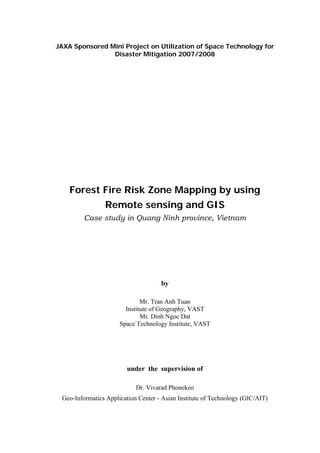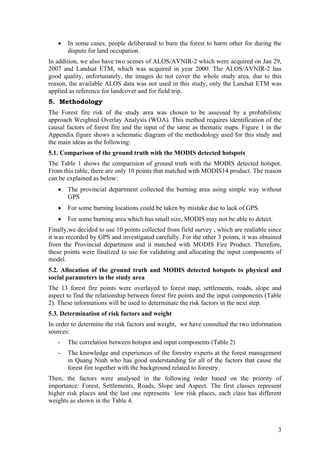This study aimed to map forest fire risk zones in Quang Ninh province, Vietnam using remote sensing and GIS. Forest fire data from MODIS and field surveys were compared to validate the analysis. Factors like forest type, proximity to roads and settlements, slope, and aspect were used as inputs to a weighted overlay analysis. This generated a risk map classifying the area into very low to very high risk zones. Most fire locations fell within high or very high risk areas, validating the model. Improving input data resolution and incorporating additional social and weather factors could enhance future analyses. The study effectively mapped forest fire risk to aid decision-making for forest management in Quang Ninh province.




![1. Forest types were reclassified according to the burning possibility (easy or difficult to
catch fire). For example: Grass, shrub or pine are very dry, which are considered to be the
most flamable (see in table 3)
2. Distance from Settlements and Roads were evaluated to have the second highest
weight. The risk factor decreases farther from these places. It means that a zone near to
these places were evaluated to have a higher rate.
3. Slope and Aspect are also important to determine risk area. As shown in Table 2, many
points are located on slope over 35 degrees. Within this slope, fire can move fastly to
close area and burn everything on the moving way because soil on this slope is very thin
and moisture is not high. In addition, Vietnam has two main monsoon season: SouthWest
in summer and NorthEast in winter. Hence, SouthWest aspect and NorthEast aspect has
high possibility for fire ocurrence and easy to increase burn area.
4. Water body or rocky mountain area do not effect to the forest fire risk, therefore, there
is no weight to determine fire rating class.
5.4. Data Processing and Weighted Overlay Analysis
Thematics map were processed in ENVI and ArcGIS software. In this step, all data and
maps were converted and registered to the WGS84-UTM projection.
To integrate the statistics and to enable the analysing process basing on different targets,
it is necessary to standardize the data: Grouping all the collected statistics into groups of
the same ones so as they can overlay and analyse. In this study, the vector format is used
to analise. Therefore, it is necessary to convert the data from vector to raster format and to
classify raster based on unique standard.
Demand: We aim to keep the same pixel size of the raster after conversion (90m, same
resolution with SRTM-DEM). For the data like forest map, buffering settlement points,
buffering roads network, the conversion process from vector to raster is done by the
software ArcMap with the support of Spatial Analyst. (Figure 1 to Figure 6)
To integrate the information using the above formular with raster, we can use the tools in
the softwares GIS such as: “Map Calculation” or “Weighted Overlay”. To facilitate the
calculating process, the authors choose the tool WO in ArcGIS (Figure 7)
The cell values in all the file raster need to be in the integer and have the same value
“scale value”: 1-5 before Weighted Overlay. The tool used for classifying is: Reclassify
tools in Spatial Analyst.
These raster statistics are classified into the calculatable values: 1-5 and each data raster
file is evaluated by one of the weight. The cell values of the file outputs are calculated on
the following formula:
Susceptibility Index Map = [(Rated Forest x 0.4) + (Rated Settlement x 0.2)
+ (Rated Road x 0.2) + (Rated Slope x 0.1) + (Rated Aspect x 0.1)]
6. Results and discussion
Each factor was fixed with a scale value and after that we used Weight Overlay function
to build up it. On the final map (Figure 8), we classify into 5 level of forest fire risk from
Very low risk to Very high risk. 13 in 30 forest fire points from the ground truth and FPD
which has exactly posittion were putted on the final map and all thematics map to validate
and compare. The corresponding statistical summary of this study area is given in Table
5. It could be seen that there are 8 hotspots (61,53%), 3 points (23.07%) fall into Very
4](https://image.slidesharecdn.com/chay-rung-1255236979-phpapp02/85/Chay-Rung-5-320.jpg)










